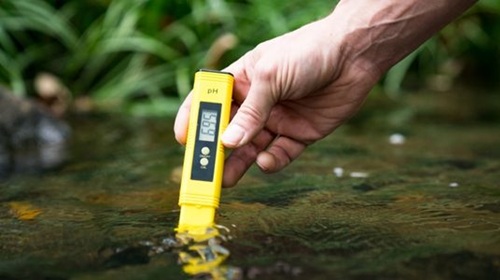May 31st 2025
Why Controlling pH is Important in Hydroponics
With its many benefits over conventional soil-based agriculture, hydroponic farming is a growingly popular cultivation technique. Keeping nutrient solutions' pH levels at ideal levels is essential to hydroponic farming success. This blog will cover the significance of pH regulation, methods for measuring and modifying pH levels, and advice for keeping your hydroponic system within the optimal pH range.
What is pH and its Significance in Hydroponic Systems
"Potential of Hydrogen," or pH, is a metric used to quantify how basic or acidic a solution is. Seven is considered neutral, less than seven is considered acidic, and more than seven is considered basic on the pH scale, which runs from 0 to 14. Because the pH scale is logarithmic, a pH of 4 is 10 times more acidic than a pH of 5.

Keeping the pH levels in check is essential to a hydroponic system's overall effectiveness. The plant's capacity to absorb nutrients from the water solution is directly impacted by the pH level. Plant growth and development may be hampered by nutritional deficits or toxicities caused by an excessively high or low pH. So, the pH level must be continuously monitored and kept within the ideal range.
Optimal pH Range for Hydroponic Systems
Although certain crops, like lettuce, may prefer slightly lower pH values and others, like tomatoes, may thrive better with slightly higher levels, most hydroponic systems work best with a pH range of 5.5 to 6.5.
- If the pH is too low (less than 5.5), plants will have reduced access to nutrients like calcium, magnesium, and phosphorus, which can result in nutritional shortages.
- When the pH is excessively high (>6.5), several important minerals, especially iron, manganese, and zinc, experience nutrient lockout, which hinders plant growth.
To keep this equilibrium, the pH must be regularly checked and adjusted. In this procedure, pH meters and pH adjusters (alkaline or acidic solutions) are crucial instruments. A pH buffer can also be used to assist stabilize variations.
Why pH Changes in Hydroponic Systems
Changes in pH in hydroponic systems can be caused by a number of variables. As the plants consume the nutrients, the nutrient solution is increasingly concentrated when the volume is less than one gallon. As a result, the pH varies significantly. Thus, it's important to keep an eye on nutrition levels, and periodically check the pH. A hydroponic system's pH can be impacted by both organic and inorganic materials. The two main organic kinds that alter pH are bacteria and algae. Algae might be the cause if the pH increases in the morning and decreases later in the day.
How to Monitor Water pH
In hydroponics, there are three primary ways to check the pH of the water: a pH controller, a digital pH pen, and pH testing strips. Using pH testing strips is one of the most popular ways to keep an eye on the pH of the water in hydroponics. These are extremely thin and tiny sheets that have been treated with a unique chemical that changes their color when dipped in liquid of any type. This ought to inform you of your nutrition solution's pH level.
A digital pH pen is your next available option. Another name for this is a pH meter. It is an easy yet powerful electronic instrument used to determine the solution's pH level, and a cost-effective instrument for determining the alkalinity or acidity of a solution. For those looking for precise readings and temperature correction, pH pens are easy to use.

For accurate and convenient pH level maintenance, automated pH controllers and dosing devices are available. These devices automatically dose the nutritional solution with the appropriate pH adjuster after continually monitoring the pH. They are perfect for commercial enterprises or bigger hydroponic systems.
How to Adjust pH
Similar to changing the pH of the soil, maintaining the proper pH in your hydroponic system routinely calls for adjustments. The most popular methods for raising or lowering pH are by using pH Up and pH Down.
pH Up: When the pH of the nutritional solution is too low, pH increasers are used to bring it up. Calcium carbonate and potassium hydroxide are often used pH raisers. The pH level is progressively raised by these chemicals' reaction with the solution. To prevent sharp pH fluctuations, it is crucial to use pH Up according to the manufacturer's recommendations and make changes gradually.
pH Down: When the pH of the nutritional solution is excessively high, pH decreasers are employed to bring it down. Citric acid and phosphoric acid are commonly used in pH Down solutions. Avoid introducing too much pH Down all at once, since this might cause abrupt pH decreases that could harm the plants.
Other Methods for Adjusting Water pH in Hydroponics
Natural Methods: Natural pH buffering agents can decrease pH changes and assist stabilize pH. For example, dolomite lime may supply vital elements like calcium and magnesium and progressively raise pH. Compost and worm castings are examples of organic materials that can support pH stability.
Automated pH Controllers: The pH controller, is the most sophisticated method of keeping an eye on the pH of a nutrient solution. This electronic gadget measures the concentration of hydrogen ions in a solution using specialized sensors and shows the result on a screen. A competent pH controller should be able to automatically alter the pH of the nutrition solution, but it does much more than that. These systems are fully equipped with dosing pumps, a controller unit, and pH sensors.
Small reservoirs containing pH Up and pH Down solutions are connected to those dosing pumps, allowing the system to automatically adjust as necessary. The pH may be adjusted to a precise value, and the controller will automatically adjust if it detects that the pH is outside of the permitted range.
Final Thoughts
Hydroponics is a great technique to grow plants since it can be done anywhere, yields more, allows you to manage the environment, and requires fewer resources. Understanding the significance of pH and being able to adjust it to the various requirements of the plants are essential for effective hydroponic gardening.
In hydroponic systems, nutrient availability typically occurs at a pH between 5.5 and 6.5; however, each plant may have different ideal pH ranges, therefore always check the needs of the individual plant.




